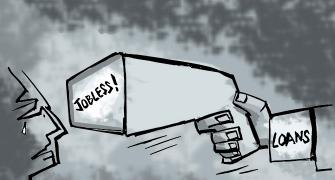'When fund managers talk of being bullish for the long term, they assume strong economic growth.'
'That is what they have assumed every year, naively believing the pronouncements and promises of ministers.'
'Unfortunately, they have been wrong year after year,' observes Debashis Basu, editor, www.moneylife.in.

All over the world, the stock markets have been rising steadily since the frightening two-week crash in March.
The Nifty and Sensex have risen almost 40 per cent from the bottom on March 24, which flies in the face of the bleak economic prospects we see all around.
Are we in a new stealth bull market?
It is indeed true that, while we are fixated on the current situation, the market looks ahead, especially when things look dire and are about to turn.
Perhaps investors are enthused by the flattening of the virus transmission curve in Western Europe, East Asia, and China, even though it is raging in India and parts of Latin America, and also rising a bit in the US.
The more plausible reason for the bullishness in India is the bigger, bolder and a more decisive rally in the US markets; it is empowering investors to buy Indian stocks.
What then is fuelling the US 'bull market'?
One, there is a race to develop a vaccine and we will soon have a winner.
Two, if the economy or Covid gets any worse, the US will flood the economy with more liquidity and that is good for the stocks.
Alas, neither of these two arguments is applicable to India. The cost of vaccines would be exorbitant and in limited supply for a long time. And India has no money to flood the economy with cash.
The biggest issue is this: If life in the US returns to normal, it will be a healthy normal for them.
Before Covid hit the world, the US had the lowest unemployment rate in 50 years, corporate taxes were among the lowest in the world, and companies were flush with funds.
What was the economic condition in India before Covid?
Every sector -- infrastructure, capital goods, real estate, metals, finance, and the auto sector -- was in the grip of a severe slowdown.
For a stock to go up, it has to have tailwinds.
For many stocks to go up at the same time, the most important parts of the economy -- construction, auto, finance, basic materials, consumer products -- have to enjoy tailwinds.
When analysts and fund managers talk of being bullish for the long term, they assume strong economic growth. That is what they have assumed every year for the last few years, naively believing the pronouncements and promises of ministers and secretaries.
Unfortunately, they have been wrong year after year.
Based on expected economic growth, analysts have also been projecting double-digit earnings growth for companies in the Sensex and Nifty, only to find actual figures being way off the mark.
It is worth remembering that the market index has barely doubled in 10 years, which means a compound average growth rate of just 6.84 per cent. Taking the peak index in January, it was still only 8.7 per cent.
How have so many smart people got it so wrong, repeatedly?
The simple reason is that analysts and fund managers are usually blind to the influence of macroeconomic factors on corporate performance. They remain narrowly focused on quarterly numbers of companies without going deeper into what is causing or hindering their performance.
This is why a well-known equity fund bet a lot of investors' money since 2012 on stocks like State Bank of India, capital goods and public sector companies, hoping for economic growth to spurt.
The result was a big disappointment.
All through the 2009-2015 period, consumer goods companies and financials were enjoying strong tailwinds, which came from government spending and generous loans advanced by public sector banks. This created an environment of economic expansion and partly, a false boom.
Economic expansion is missing today. We are in a period of economic contraction that a lot of people remain blind to. That explains the poor index returns.
There is another huge false belief among analysts and fund managers. It is the near universal belief that economic growth will automatically translate into better corporate performance.
Here is the math they peddle.
If the economy grows at 6 per cent and inflation is at 5 per cent, then we have 11 per cent nominal growth, which will be reflected in the revenues of companies.
And better companies -- those in the index -- would do even better, and may have 15 per cent growth in revenues.
This is pure nonsense, as evident from the single-digit growth in revenues (in a period when GDP growth was 7 per cent and inflation was 8 per cent) of the some of the largest and best Indian companies.
If these companies cannot grow their revenue, at least by the nominal growth, then either the GDP figure is wrong or the theory (translating GDP growth into corporate revenue growth) is rubbish. But this belief is strongly held.
In a way, the situation today is opposite to what it was in 2008. Today the market is rising effortlessly while we have huge economic headwinds. In 2008 while markets was crashing for global reasons, the economic expansion was still on track.
In November 2008, in a conversation with Moneylife, I remember HDFC Bank MD Aditya Puri telling us that HDFC Bank had the highest card usage that Diwali. This is not the situation today.
We will get a big, onetime boom in pent up demand when we return to normal life and the markets may head higher, but remember, the economic normal before Covid was already very weak.
That has to change for a sustainable bull run.










